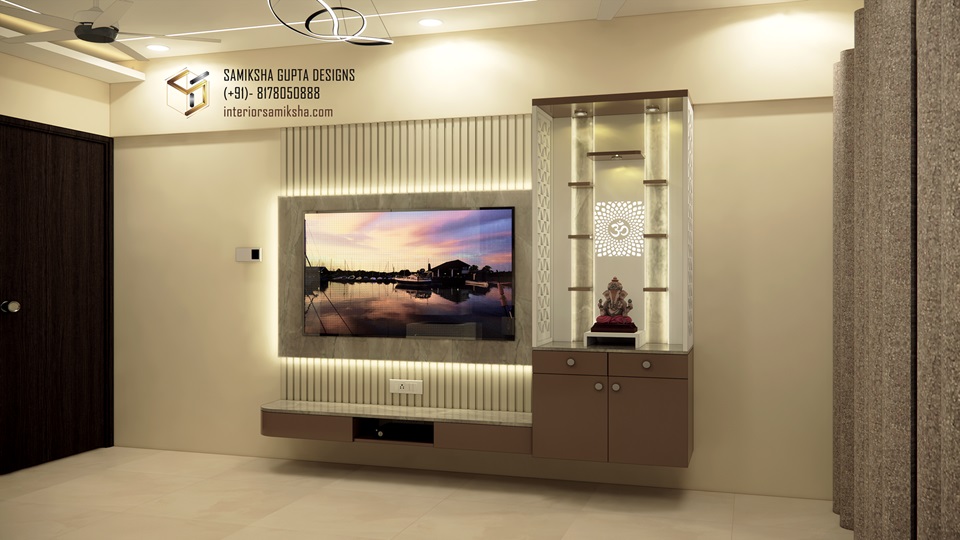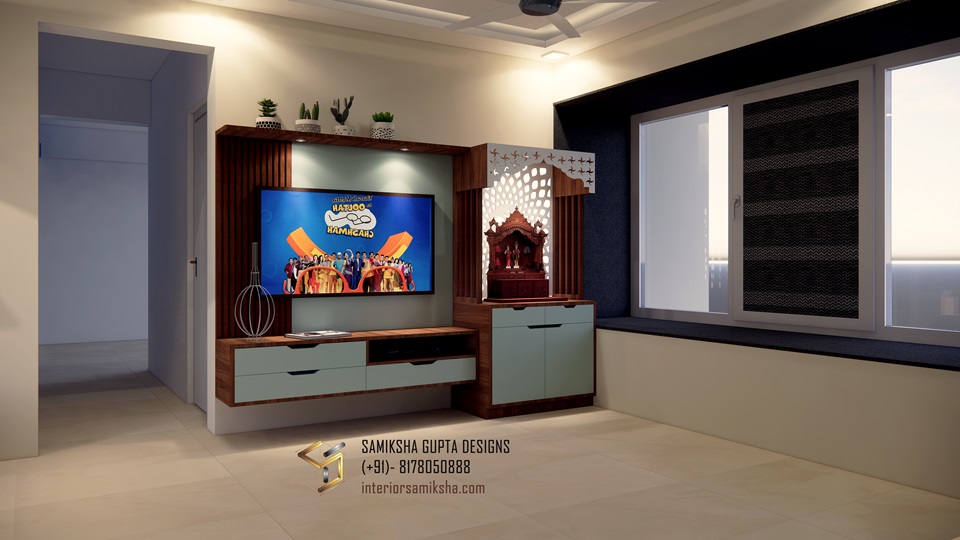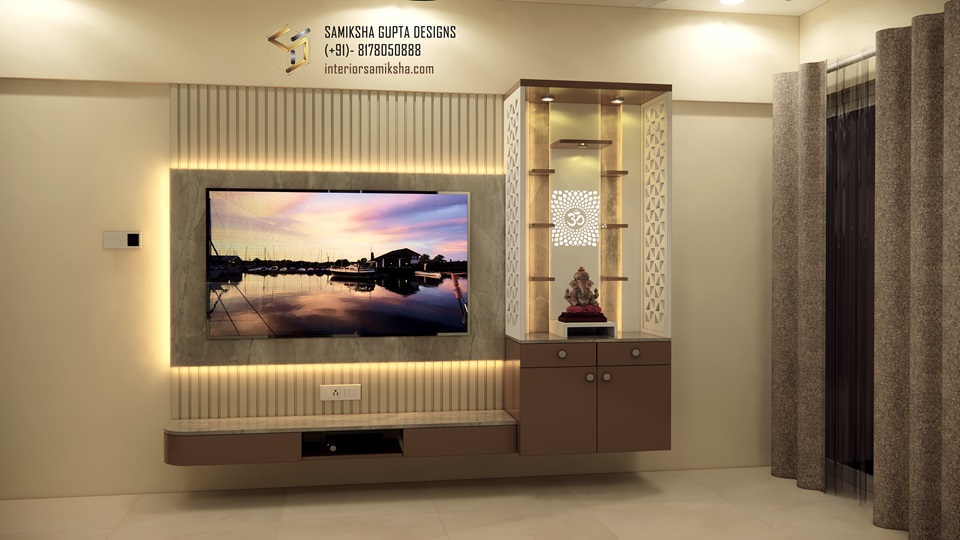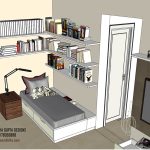A lot of time in my process of designing a living area of a house, I have to combine the TV unit and the mandir for all sorts of reasons. The reasons are usually:
- Technical feasibility of the area
- Vastu compliance
- Space available
While it is not uncommon to have a combined TV and mandir unit, it can sometimes be tricky. You want the entire setup to look like a combined unit. But at the same time, you want to separate the mandir from the TV unit.
We have all kinds of solutions for that.
In some cases, we opt to maintain a consistent colour theme while creating a false partition between the two units.
Alternatively, we may enclose the mandir from all four sides, giving it the appearance of a distinct, standalone unit. As another option, one might choose to add a shutter to the mandir cabinet, as I have done in my own setup.
It’s important to explore various design approaches to achieve the desired aesthetic and functionality in your space.
Designing a combined TV and mandir (prayer area) unit can be a thoughtful and creative project that combines both functional and spiritual elements.

If you’re also planning to combine a TV and a mandir unit, here are some steps to help you design such a unit:
-
Determine the Location:
Decide where you want to place the TV and mandir unit.
Common locations include the living room, family room, or a dedicated prayer room. There’s no better place for a Pooja space than a dedicated Pooja room. But most houses these days don’t have that much space. So, you can consider creating a Pooja space in your living room.
Examine the available space and the overall layout of the room.
-
Measure the Space:
Measure the available space to ensure that the unit fits comfortably without overcrowding the room. It’s even better if you custom-make the entire TV+ Pooja unit instead of purchasing a ready-made furniture unit.
Consider the dimensions of the TV, mandir, and any additional features you want to include.
You can also hire a professional designer to do this for you if all this confuses you.
-
Choose a Style:
Decide on the overall style and aesthetic of the unit. You can go for a traditional, contemporary, or a fusion of both, depending on your personal preferences and the existing decor of your home.
When I was designing the TV+ mandir unit, my client had an idea in mind that they wanted to materialize. They wanted all the edges or corners of the unit to be curved. They wanted to avoid any sharp or straight edges, the reason being, that the house was to be lived in by their old parents and hence, the client wanted it to be safe from all the sharp corners. And I tried my best to cater to it.

-
Design the TV Cabinet:
Create a design for the TV cabinet, considering the size of the TV (very important, and a lot of people miss this part, idk why) and any storage requirements for devices, cables, and media.
Ensure proper ventilation and cable management for a clean look.
Try to design the TV unit in such a way that, if not all, most of the wires are concealed. You can do panelling behind the TV and have some wires out of sight in the open cabinet below, behind the set-top box, etc.
-
Design the Mandir:
Design the mandir section of the unit. Consider the size and design of the idols, the placement of the sacred space, and any elements like bells, incense holders, and offering trays.
Different people want to have different arrangements of idols inside their mandir. Some people have n number of small idols that they want to arrange evenly in the unit.
Usually, small shelves on either side of the central element suffice. But if you have a big idol or a portrait, you can keep it in the centre and make it the focal point of the unit with light effects on it.
You may choose a closed cabinet for the mandir or an open shelving design.
-
Incorporate Lighting:
Adequate lighting is crucial for both the TV and the mandir.
Consider incorporating ambient and task lighting for the mandir, including LED strips, pendant lights, or recessed lighting.
These days, having a backlit acrylic/ MDF jaali as a backdrop for the mandir is a trend.
Ensure that the TV area has proper lighting for viewing.
-
Materials and Finishes:
Choose appropriate materials and finishes that match the overall design.
Common choices include wood, MDF, laminate, or a combination of materials. You can even do tile cladding behind the TV.
You can have intricate carvings and decorative elements on the mandir section to give it a spiritual feel. -
Storage and Organization:
Plan for storage solutions to keep the area neat and organized.
Consider drawers, shelves, and cabinets to store prayer essentials, remote controls, and other items.
-
Accessories and Decor:
Add decor elements like wall art, cushions, or curtains that complement the design and create a harmonious atmosphere.
-
Ventilation and Wiring:
Ensure proper ventilation for both the TV and the mandir to prevent overheating. Conceal wires and cables to maintain a tidy appearance.
-
Customization:
If possible, consider customizing the unit to match your specific needs and preferences. Custom-made furniture can ensure that it perfectly fits your space and requirements.
12. Safety and Functionality:
When setting up your mandir, it’s crucial to pay close attention to safety concerns, particularly if you have children or pets. Therefore, make sure the mandir is secure, and double-check to ensure there are no exposed wires that could pose a danger.
13. Personal Touch:
To truly make the space your own, take the opportunity to personalize the unit with items that hold sentimental value to you and your family. This can include family pictures, heirlooms, or other cherished possessions.
14. Consult a Designer/Professional:
If you’re unsure about the design or need assistance with structural aspects, it’s advisable to consult with a professional interior designer or carpenter who specializes in custom furniture.
Remember that a TV and mandir unit is a fusion of technology and spirituality; therefore, it’s important to strike a balance between the two elements, ensuring that you create a harmonious and functional space that truly suits your lifestyle and beliefs.





